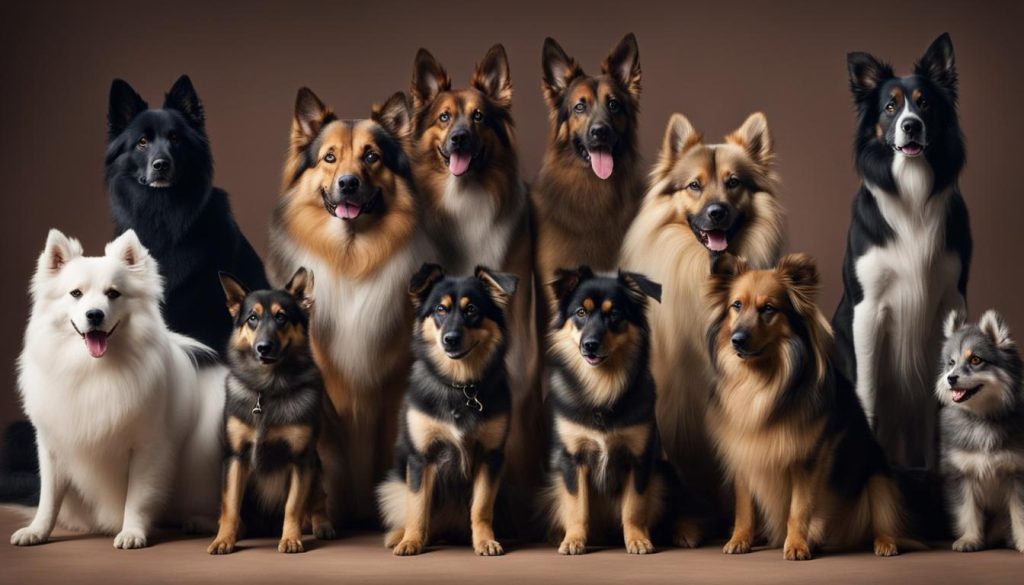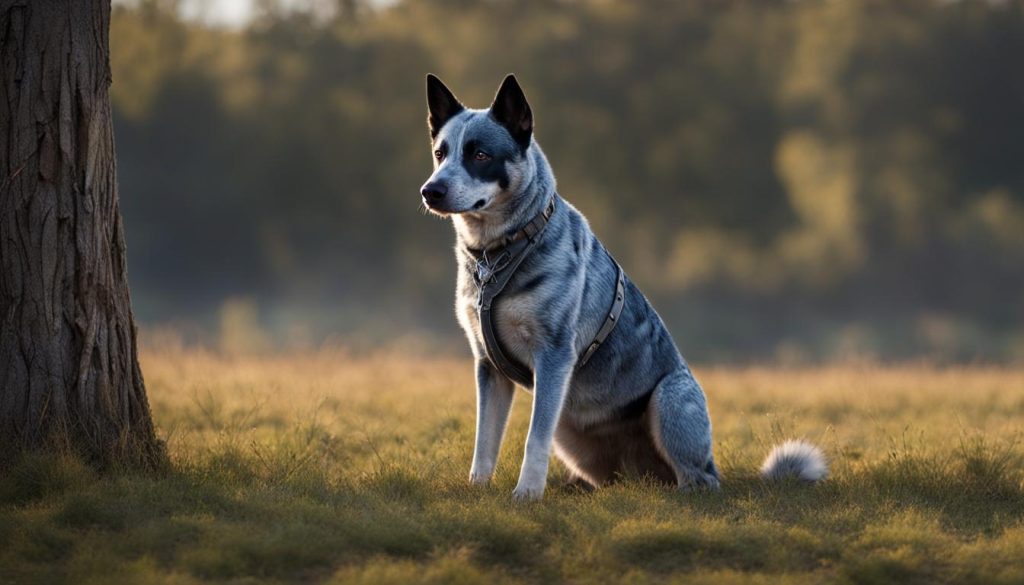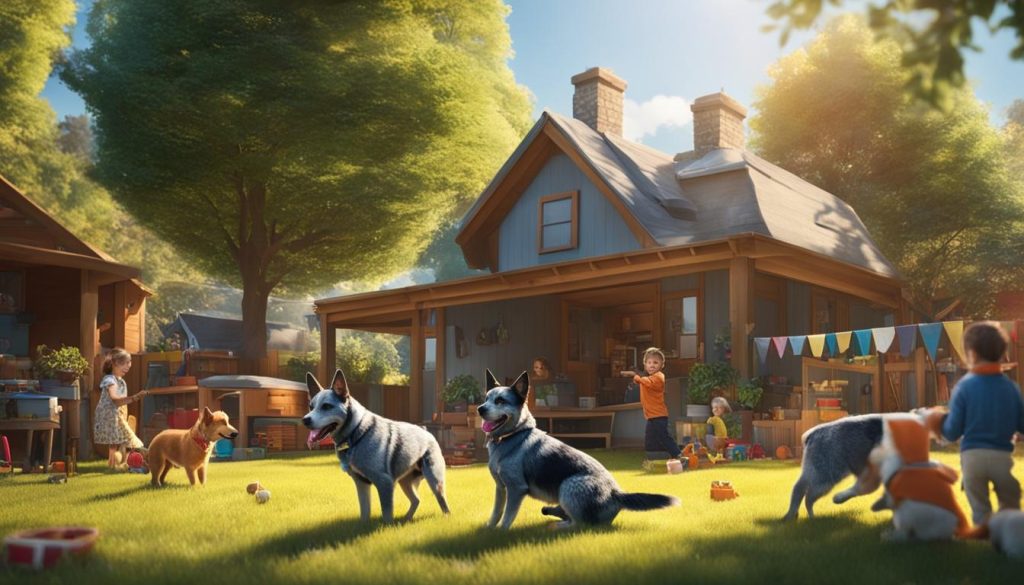Greetings! As a professional journalist, I am excited to delve into the fascinating world of Bluey dog breeds. Known for their energetic nature, curiosity, and intelligence, Bluey dogs make exceptional companions for kids. In this article, I will provide you with valuable insights and information about Bluey dog breeds, including their characteristics, temperament, and care.
Key Takeaways:
- Bluey dog breeds are loyal, loving, and inexhaustible, making them perfect companions for kids.
- Bluey dogs, also known as Australian cattle dogs or blue heelers, are medium-sized with lots of energy and a curious nature.
- Bluey’s family consists of her parents, Bandit and Chilli, and her sister, Bingo, all of whom are blue heelers.
- Bluey has various friends in the show, each representing a different dog breed, adding diversity to the series.
- The popularity of “Bluey” has increased interest in Australian cattle dogs as pets, but proper care and commitment are essential.
The Bluey Breed: A Closer Look at Australian Cattle Dogs

Bluey and her family are Australian cattle dogs, also known as blue heelers. These dogs have a medium-sized body, lots of energy, and a curious nature. Australian cattle dogs were originally bred in Australia to work cattle, and they are known for their intelligence, loyalty, and loving nature.
Here are some key facts and characteristics of the bluey breed:
- History: Australian cattle dogs were developed in the 19th century by crossing British herding breeds with dingoes. The breed is named after an exceptional blue heeler named Bluey, who lived for 29 years, making him the oldest dog on record.
- Appearance: Blue heelers have a muscular build, with a broad skull and a strong neck. They have a short, dense coat that comes in blue or red speckled patterns, which helps to protect them from the harsh Australian climate.
- Temperament: Blue heelers are highly intelligent and alert. They are known for being hardworking, loyal, and protective of their families. These dogs have a strong herding instinct and may try to herd children or other animals.
- Training: Due to their intelligence, blue heelers are quick learners and respond well to positive reinforcement training methods. Early socialization and consistent training are important to ensure they grow into well-behaved and well-adjusted dogs.
- Exercise Needs: Blue heelers are an active breed and require plenty of physical exercise to keep them mentally and physically stimulated. They thrive in environments where they have space to run and play.
Whether you’re a fan of the “Bluey” show or simply interested in Australian cattle dogs, the bluey breed offers a unique combination of intelligence, loyalty, and energy. However, it’s important to remember that these dogs require dedicated training, exercise, and mental stimulation to thrive as companions.
| Bluey Breed Facts | Bluey Breed Characteristics |
|---|---|
| Origin: Australia | Size: Medium |
| History: Developed in the 19th century | Coat: Short and dense |
| Temperament: Intelligent, loyal, protective | Colors: Blue or red speckled |
| Training: Responds well to positive reinforcement | Activity Level: High |
| Exercise Needs: Requires ample physical activity | Herding Instinct: Strong |
Bluey Character Spotlight: Meet the Heeler Family

Bluey’s family, the Heelers, play a central role in the popular children’s show. They are all blue heelers, also known as Australian cattle dogs, and share the same breed characteristics. The Heelers consist of Bluey, her parents Bandit and Chilli, and her sister Bingo.
Bandit and Chilli are portrayed as loving and caring parents who deeply adore their daughters. However, they sometimes struggle to match the boundless energy and enthusiasm of their children. The Heeler family’s dynamics are relatable to many families who have kids with an abundance of energy.
Australian cattle dogs, like the Heelers, are known for their intelligence, loyalty, and high energy levels. They require regular exercise and mental stimulation to keep them happy and fulfill their herding instincts. The show portrays the Heeler family’s day-to-day adventures, showcasing how they navigate the challenges and joys of family life.
The Heeler Family Members
In the Heeler family, Bluey is the main character and the one who drives the show’s narrative. She is a curious and adventurous dog who loves to play and explore. Bingo, Bluey’s younger sister, is also full of energy and often joins Bluey on her imaginative adventures. Bandit, the father, is a fun-loving and playful dog who enjoys spending time with his daughters. Chilli, the mother, is depicted as nurturing and caring, always supporting her family.
Together, the Heeler family exemplifies the energetic and loving nature of blue heelers, providing entertainment and relatable moments for both children and adults watching the show.
| Character | Traits |
|---|---|
| Bluey | Curious, adventurous, energetic |
| Bingo | Full of energy, imaginative |
| Bandit | Fun-loving, playful |
| Chilli | Nurturing, caring |
The Bluey Friends: Other Dog Breeds in the Show

Bluey, the popular animated show, features a diverse cast of dog characters that represent different breeds. These characters add depth and variety to the show, showcasing the unique characteristics of each breed. Let’s take a closer look at some of Bluey’s friends and the breeds they represent:
Bluey’s Friends:
| Character | Breed | Characteristics |
|---|---|---|
| Calypso | Australian Shepherd | Intelligent, active, and highly trainable |
| Chloe | Dalmatian | Energetic, friendly, and known for their unique coat pattern |
| Rusty | Red Heeler | Loyal, protective, and has a strong herding instinct |
Calypso, the Australian Shepherd, is a smart and active dog known for their herding abilities. They are highly trainable and excel in various dog sports. Chloe, the Dalmatian, is energetic, friendly, and instantly recognizable by their distinctive coat pattern. Dalmatians are known for their outgoing nature and make great family pets.
Rusty, the Red Heeler, shares a similar breed background with Bluey as a cattle dog. Red Heelers are loyal and protective companions, often displaying a strong herding instinct. These diverse characters bring unique perspectives and personalities to the show, captivating audiences of all ages.
“Bluey’s friends represent a wide range of dog breeds, allowing viewers to learn about different characteristics and traits. It’s a wonderful opportunity to showcase the diversity and beauty of the canine world.”
As the show continues to captivate audiences around the world, Bluey and her friends serve as ambassadors for their respective breeds. They inspire curiosity and appreciation for the different qualities each breed brings to the table, fostering a love for dogs and promoting responsible pet ownership.
The Bluey Effect: The Impact of the Show on Dog Adoption
Since the premiere of the animated series “Bluey,” there has been a noticeable impact on the adoption rates of Australian cattle dogs, also known as blue heelers. The show’s charming portrayal of Bluey, a blue heeler puppy, and her adventures with her family has captured the hearts of viewers around the world. As a result, more families are considering adding a blue heeler to their household.
It is important to recognize that owning a blue heeler requires a significant commitment in terms of care, training, and meeting their exercise needs. While the show depicts Bluey as a loyal and loving companion, it also showcases the energetic and inquisitive nature of this breed. Prospective owners must understand that blue heelers are intelligent, high-energy dogs that thrive on mental stimulation and physical activity.
Before deciding to adopt a blue heeler, it is crucial to research and understand the breed’s characteristics and care requirements. Blue heelers are not suitable for apartment living due to their need for ample space to run and play. They are best suited for active families who can provide the exercise and mental stimulation they need. Additionally, blue heelers may not be suitable for families with young children, as their herding instincts may lead to nipping or chasing behaviors.
| Breed Characteristics | Blue Heeler |
|---|---|
| Temperament | Energetic, intelligent, loyal |
| Size | Medium-sized |
| Coat Color | Bluish-gray |
| Exercise Needs | High |
| Training Requirements | Consistent, positive reinforcement |
While the popularity of “Bluey” has undoubtedly led to increased interest in blue heelers, potential owners must be prepared to provide the necessary care and attention these dogs require. Adoption should be a well-informed decision made after careful consideration of the breed’s compatibility with the family’s lifestyle and ability to meet their needs.
What is a Blue Heeler? Understanding the Breed

Blue heelers, also known as Australian cattle dogs, are energetic and intelligent dogs that were originally bred for herding cattle. They have a strong work ethic and excel in tasks that require agility, stamina, and problem-solving skills. Blue heelers are medium-sized dogs with a bluish-gray coat that can have speckles or patches of other colors.
One of the key characteristics of blue heelers is their high energy level. They are active dogs that require regular exercise to keep them physically and mentally stimulated. Daily walks, runs, or engaging play sessions are essential for their well-being. Without enough exercise, blue heelers can become bored and develop destructive behaviors.
In addition to their energy, blue heelers are known for their intelligence and trainability. They are quick learners and excel in obedience training and various dog sports. However, their intelligence also means that they can be independent and sometimes stubborn. Consistent and positive reinforcement training methods are crucial to ensure a well-behaved blue heeler.
| Blue Heeler Characteristics | Blue Heeler Temperament |
|---|---|
| – Energetic | – Loyal |
| – Intelligent | – Protective |
| – Agile | – Alert |
| – Hardworking | – Curious |
Blue heelers are known for their loyalty and protective nature. They form strong bonds with their families and can be wary of strangers. Early socialization is essential to ensure that they are comfortable and well-behaved around other people and animals.
Blue Heelers vs. Other Dog Breeds
When comparing blue heelers to other dog breeds, their herding instinct sets them apart. Blue heelers have a strong drive to control movement and may try to herd children or other pets in the household. While this behavior can be managed through training, it can also make blue heelers less suitable for families with young children or smaller animals.
However, blue heelers can make excellent companions for active families who can provide them with the mental and physical stimulation they need. Their loyalty, intelligence, and agility make them suitable for various dog sports and activities. With proper training, socialization, and care, blue heelers can thrive in a loving and active household.
The Blue Heeler’s Role in “Bluey”: Energetic and Adventurous

Blue heelers, like the beloved character Bluey, play a significant role in the hit show “Bluey.” These energetic and adventurous dogs bring a sense of fun and excitement to every episode. Just like their on-screen portrayal, blue heelers in real life are known for their high energy levels and curiosity.
In the show, Bluey’s energetic nature and adventurous spirit are showcased through her various escapades and imaginative play. Whether she’s exploring the backyard, embarking on a make-believe adventure, or engaging in a spirited game with her family and friends, Bluey embodies the active and curious nature of blue heelers.
Blue heelers are smart and driven dogs that thrive on having a job to do. They are highly trainable and excel in activities such as obedience, agility, and herding trials. This breed’s unwavering loyalty and dedication make them ideal companions for active families who can provide them with the exercise, mental stimulation, and structured activities they need.
The energetic and adventurous nature of blue heelers, as portrayed in “Bluey,” highlights the importance of providing these dogs with outlets for their energy and curiosity. By understanding and meeting their needs, blue heelers can make excellent companions for families who are ready to embark on exciting and active adventures with their furry friends.
Blue Heelers: Not for Apartment Living
When considering the ideal living situation for a Blue Heeler, apartment living may not be suitable for this energetic breed. Blue Heelers require ample space to run and play, as well as mental stimulation to keep them happy and prevent destructive behaviors.
Blue Heelers, also known as Australian cattle dogs, are medium-sized dogs with a strong work ethic. They were bred for herding cattle and have a natural inclination to be active and on the move. Without adequate exercise and mental stimulation, Blue Heelers may become bored and exhibit unwanted behaviors, such as excessive barking or chewing.
In an apartment setting, it can be challenging to provide Blue Heelers with the physical and mental stimulation they need. These dogs thrive when given the opportunity to explore their surroundings, and being confined to a small apartment may lead to frustration and restlessness. Additionally, Blue Heelers have a strong instinct to herd, which can manifest as nipping or chasing family members or other pets in a confined space.
It’s important to consider the needs and nature of Blue Heelers before bringing one into an apartment. If you live in an apartment and are set on having a dog, consider exploring other breeds or smaller-sized dogs that are better suited to apartment living. Alternatively, if you have access to nearby parks or open spaces where you can provide ample exercise and mental stimulation for a Blue Heeler, apartment living may be feasible.
Table: Blue Heeler Living Requirements
| Living Environment | Suitability |
|---|---|
| House with a fenced yard | Highly suitable |
| Apartment with limited outdoor space | Not suitable |
| Access to nearby parks or open spaces | Can be suitable with adequate exercise |
| Country or rural setting | Highly suitable |
Ultimately, providing a suitable living environment for a Blue Heeler is essential for their well-being. These intelligent and active dogs thrive when given the opportunity to fulfill their natural instincts and exercise needs. If you are unable to meet the requirements of a Blue Heeler in an apartment setting, it may be best to consider alternative breeds or living arrangements that can better accommodate their energy levels and instincts.
Blue Heelers as Family Dogs: Things to Consider

Blue heelers, also known as Australian cattle dogs, can make wonderful family dogs. However, there are some important factors to consider before bringing one into your home. While blue heelers are loyal, loving, and thrive on human companionship, their herding instincts may not be suitable for families with young children.
Blue heelers are known for their high energy levels and need for mental stimulation. They require an active lifestyle and plenty of exercise to keep them happy and prevent destructive behaviors. This means that families with older children who can actively participate in the dog’s life may be better suited to owning a blue heeler.
It’s important to remember that blue heelers are intelligent dogs. They require consistent training and socialization from an early age to prevent behavioral issues. Proper training will help them understand their role in the family and ensure they are well-behaved companions.
| Pros of Blue Heelers as Family Dogs | Cons of Blue Heelers as Family Dogs |
|---|---|
| Highly loyal and loving | May not be suitable for families with young children |
| Active and energetic companions | Require consistent training and socialization |
| Thrive on human companionship | Need plenty of exercise and mental stimulation |
“Blue heelers can be excellent family dogs for families with older children who can actively engage with them. However, it’s essential to be mindful of their herding instincts and energy levels, as they may not be the best fit for families with young children.” – Professional Dog Trainer
Before deciding to bring a blue heeler into your family, it’s important to research and understand the breed’s characteristics and care requirements. Providing the right environment, training, and socialization will ensure that your blue heeler thrives and becomes a cherished member of your family.
Preparing for a Blue Heeler: Training and Socialization
When bringing home a Blue Heeler, it is imperative to invest time and effort in their training and socialization. These intelligent and energetic dogs require mental stimulation and consistent, positive reinforcement training to thrive.
Early socialization is essential for Blue Heelers to ensure they are comfortable and well-behaved around other people and animals. This can be achieved by exposing them to different environments, sights, sounds, and experiences from a young age. Introducing them to new people, dogs, and situations will help them develop confidence and reduce the likelihood of fear-based aggression.
Training Blue Heelers should focus on setting clear boundaries and establishing leadership. They respond well to positive reinforcement techniques such as rewards, praise, and treats. It is important to be patient, consistent, and firm in the training process. Blue Heelers are highly intelligent and can quickly pick up commands and tasks, so utilizing their natural abilities in activities like obedience training, agility courses, and interactive games can keep them engaged and mentally stimulated.
Training Tips for Blue Heelers:
- Start training early and be consistent with the rules and commands.
- Use positive reinforcement techniques, such as rewards and praise, to motivate and encourage good behavior.
- Provide mental stimulation through interactive games, puzzles, and training activities to prevent boredom.
- Enroll in obedience classes or seek professional training assistance if needed.
- Establish a routine and provide regular exercise to channel their energy in a positive way.
By investing time and effort into training and socializing a Blue Heeler, you can ensure they grow into well-behaved, confident, and happy companions. Remember, each Blue Heeler is unique, so tailor the training approach to their individual temperament and personality.
| Training Tips for Blue Heelers: |
|---|
| Start training early and be consistent with the rules and commands. |
| Use positive reinforcement techniques, such as rewards and praise, to motivate and encourage good behavior. |
| Provide mental stimulation through interactive games, puzzles, and training activities to prevent boredom. |
| Enroll in obedience classes or seek professional training assistance if needed. |
| Establish a routine and provide regular exercise to channel their energy in a positive way. |
Caring for a Blue Heeler: Exercise and Grooming
Taking care of a Blue Heeler involves meeting their unique exercise and grooming needs. As an energetic breed, Blue Heelers require daily exercise to keep them physically and mentally stimulated. Regular walks, runs, and play sessions are essential to prevent boredom and the development of destructive behaviors. Engaging in activities that can challenge their intelligence, such as puzzle toys or obedience training, can also help keep them mentally sharp. Please be aware that Blue Heelers are not well-suited for apartment living due to their high energy levels.
Grooming a Blue Heeler is relatively low-maintenance. They have a short coat that sheds moderately year-round. Regular brushing, ideally done once or twice a week, can help remove loose hair and keep their coat healthy. Paying attention to their ears is also crucial, as Blue Heelers are prone to ear infections. Check their ears regularly for signs of redness, swelling, or a foul odor and clean them as needed. Additionally, remember to trim their nails regularly to prevent overgrowth and discomfort.
| Exercise Needs | Grooming |
|---|---|
| Blue Heelers require at least an hour of exercise every day. | Regular brushing to remove loose hair and maintain a healthy coat. |
| Engage them in activities that challenge their intelligence. | Regular ear checks and cleaning to prevent infections. |
| Avoid keeping Blue Heelers in apartments as they need ample space to run and play. | Trim their nails regularly to prevent overgrowth. |
Please be aware that each Blue Heeler may have specific exercise and grooming needs that can vary based on their individual personality and energy levels. It’s essential to spend quality time with your Blue Heeler, understanding their preferences, and tailoring their exercise routine accordingly. Regular grooming sessions also provide an opportunity to bond with your furry friend and check for any potential health issues or injuries.
Keeping Your Blue Heeler Happy and Healthy
Providing proper exercise and grooming for your Blue Heeler is crucial for their overall well-being. In addition to physical exercise and mental stimulation, ensure that they receive a balanced diet appropriate for their age and weight. Regular visits to the veterinarian for check-ups and vaccinations are also essential to keep them healthy.
- Engage in daily exercise activities that challenge their physical abilities and mental agility.
- Monitor their weight and adjust their diet accordingly to prevent obesity.
- Provide a balanced diet with high-quality dog food that meets their nutritional requirements.
- Keep up with regular vet visits for vaccinations, check-ups, and preventive care.
By prioritizing exercise, grooming, and overall care, you can ensure that your Blue Heeler remains happy and healthy. Remember, a well-cared-for Blue Heeler will reward you with unending loyalty, love, and companionship for many years to come.
Wrapping Up
To summarize, blue heelers, like Bluey, are energetic, intelligent, and loyal dogs that can make excellent companions for the right owner. However, it is crucial to understand and meet their specific care requirements.
Before bringing home a blue heeler, it is important to research the breed thoroughly and ensure that you can provide the necessary exercise and mental stimulation they need. As energetic dogs, blue heelers require ample space to run and play, making them unsuitable for apartment living.
Proper training and socialization are also key factors in raising a well-behaved blue heeler. Their intelligence and drive make positive reinforcement training methods highly effective. Similarly, early socialization will help ensure that they are comfortable around other people and animals.
With their distinctive traits and unique needs, blue heelers can be a rewarding and fulfilling addition to the right family. By understanding the breed’s characteristics and committing to their care, you can provide a loving and stimulating environment for your blue heeler companion.
FAQ
What is Bluey’s breed?
Bluey is an Australian cattle dog, also known as a blue heeler.
What are the characteristics of a blue heeler?
Blue heelers are energetic, intelligent, and loyal. They have a strong work ethic and require regular exercise and mental stimulation.
Are blue heelers good with kids?
Yes, blue heelers can make great companions for kids. They are loyal, loving, and energetic, making them the perfect playmates.
Do blue heelers require a lot of exercise?
Yes, blue heelers are an active breed that requires daily exercise to stay happy and healthy. They enjoy activities such as walking, running, and playing fetch.
Are blue heelers suitable for apartment living?
No, blue heelers are not well-suited for apartment living. They require ample space to run and play, as well as mental stimulation to prevent destructive behaviors.
Are blue heelers good family dogs?
Blue heelers can make great family dogs for families with older children who can actively participate in their care. However, their herding instincts may not make them suitable for families with young children.
Do blue heelers require special training?
Yes, proper training and socialization are crucial for blue heelers to prevent behavioral issues. They are intelligent dogs that require mental stimulation and consistent, positive reinforcement training.
How often should I groom a blue heeler?
Blue heelers have a short coat that is low-maintenance but may require regular brushing to prevent matting. Other grooming needs, such as nail trimming and ear cleaning, should also be attended to regularly.
What should I consider before getting a blue heeler?
Before getting a blue heeler, it’s important to research and understand their breed characteristics and care requirements. They require a dedicated owner who can meet their exercise and mental stimulation needs.






